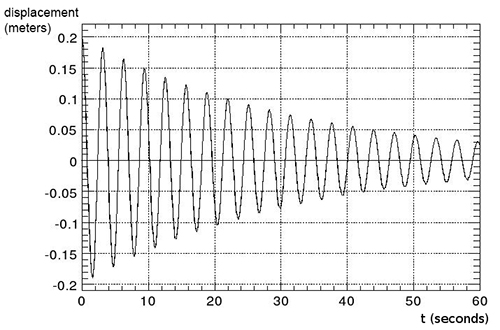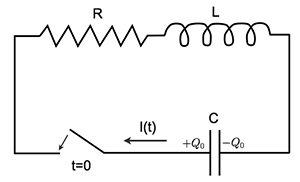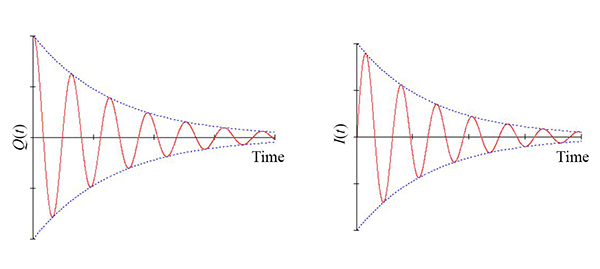Harmonic Oscillators with Damping
Problem 1
Using a force of 4 newtons, a damped harmonic oscillator is displaced from equilibrium by 0.2 meters. At t = 0 it is released from rest. The resultant displacement of the oscillator, from the equilibrium position, as a function of time, is shown in the figure below. Estimate, as well as you can using the given information:
- The mass of the oscillator.
- The quality factor of the oscillator.

The simplest way to do this problem is to obtain the equation of motion from conservation of energy.
› View/Hide Answer
Mass and Q of oscillator are approximately 5 kg and 30, respectively.
Problem 2

The circuit shown above consists of a capacitor (\(C\)), an inductor (\(L\)) and a resistor (\(R\)). Initially the switch is open and the charge (\(Q\)) on the capacitor is \(Q(t \leq 0) =Q_0\). At \(t = 0\), the switch is closed.
- For what values of \(R\), the initial sign of \(Q(t)\) will be reversed at some later times?
- Assuming that the value of \(R\) satisfies the condition in (1), find \(Q(t)\) and the current \(I(t)\) in terms of \(Q_0\), \(R\), \(L\) and \(C\). Draw qualitative sketches of both \(Q(t)\) and \(I(t)\). (Make sure to indicate the behaviour around \(t=0\)).
- If it takes 10 cycles for the energy in the circuit to decrease to \(1/e\) times its initial value, find the value of the resistance \(R\) in terms of \(L\) and \(C\).
› View/Hide Answers
1. Initial sign will be reversed only if the circuit is underdamped:
i.e., \(R < 2 \sqrt{\frac{L}{C}}\)
\[ Q(t) = Q_{0} e^{-\frac{\gamma t}{2}} \left(\cos(\omega’t) + \frac{\gamma}{2 \omega’} \sin(\omega’t)\right) \] and
\begin{align*}
I(t) &= \omega’ Q_{0} e^{-\frac{\gamma t}{2}} \sin(\omega’t) + \frac{\gamma}{2} \frac{Q_{0}\gamma}{2 \omega’} e^{-\frac{\gamma t}{2}} \sin(\omega’t)\\
&= Q_{0}\frac{\omega_{0}^{2}}{\omega’}e^{-\frac{\gamma t}{2}} \sin(\omega’t).
\end{align*}
\begin{equation}
\nonumber{\text{where} \hspace{4mm} \gamma = {\frac{R}{L}} \hspace{1mm} \text{,} \hspace{4mm} \omega_{0}^{2} = {\frac{1}{LC}} \hspace{4mm} \text{and} \hspace{4mm}
\omega’=\sqrt{\omega_{0}^{2}-\frac{\gamma^2}{4}}}
\end{equation}
Below are the sketches of \(Q(t)\) and \(I(t)\). Note that \(I(0)=0\) and both \(Q(t)\) and \(I(t)\) oscillate at the same frequency.

\[R = \dfrac{1}{20\pi}\sqrt{\dfrac{L}{C}}\]








